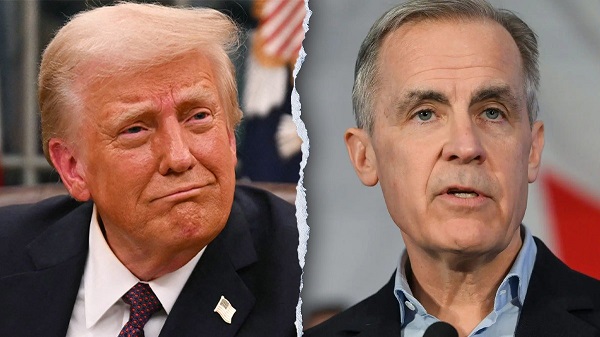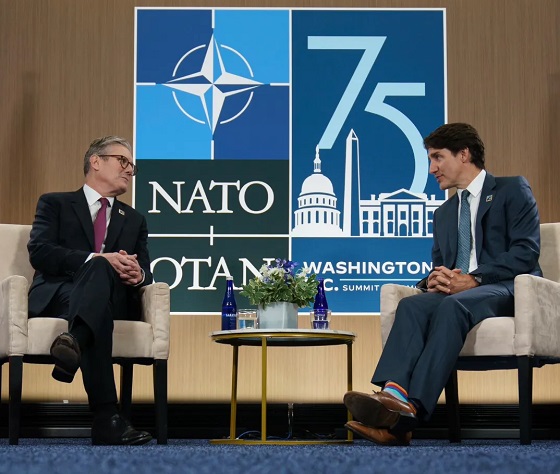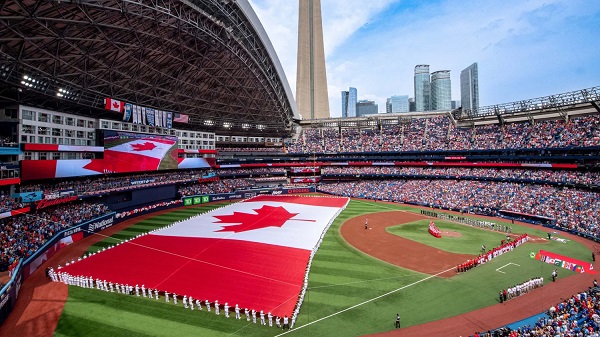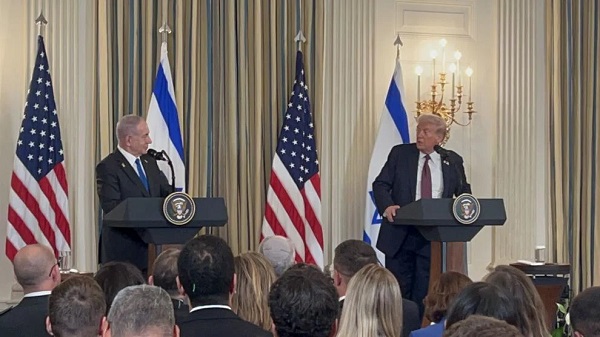Business
Canadian Taxpayers Federation looking into value of CBC properties

From the Canadian Taxpayers Federation
CBC amasses half a billion in real estate
Author: Ryan Thorpe
The Canadian Broadcasting Corporation has amassed nearly half-a-billion dollars in real estate holdings, according to documents obtained by the Canadian Taxpayers Federation.
The CBC’s real estate portfolio, comprised of 12 properties scattered across Canada, is assessed at more than $444 million. The CBC leases another 72 properties, including five in foreign countries, that it refuses to disclose costs for.
“It sure seems the CBC is spending way more on its buildings than competitors spend, but what value do taxpayers get for all these properties?” said Franco Terrazzano, CTF Federal Director. “Taxpayers have every right to question why we’re paying for all these CBC buildings in Canada and in other countries.”
Records detailing the CBC’s real estate portfolio were released in response to a written order paper question from Conservative MP Adam Chambers (Simcoe North).
CBC’s most expensive is its Toronto headquarters, which is assessed at nearly $314 million.
For context, when TorStar – the parent company that publishes the Toronto Star – was sold in 2020, the price tag for the entire newspaper chain was $52 million. And when the Calgary Herald sold its building earlier this year, it went for $17.25 million. In 2012, the Globe and Mail sold its head offices in downtown Toronto for $136 million. The National Post sold its headquarters in Toronto for $24 million in 2012.
Table: CBC-owned property, assessed municipal value
|
Location |
Value |
|
Toronto, Ont. |
$313,866,000 |
|
Vancouver, B.C. |
$99,061,000 |
|
Winnipeg, Man. |
$11,718,000 |
|
St. Johns, N.L. |
$4,439,000 |
|
Yellowknife, NWT |
$3,181,720 |
|
Fredericton, N.B. |
$2,791,000 |
|
Charlottetown, P.E.I. |
$2,631,800 |
|
Saguenay, Que. |
$2,485,939 |
|
Whitehorse, Yuk. |
$1,847,410 |
|
Winnipeg, Man. |
$1,541,000 |
|
Thunder Bay, Ont. |
$537,000 |
|
Rankin Inlet, Nun. |
$314,600 |
|
Total |
$444,414,469 |
The CBC is refusing to disclose what it spends on the 72 other properties it currently leases in Canada and abroad, citing it as “commercially sensitive information.”
Outside of Canada, the CBC leases property in London, U.K., Mumbai, India, Paris, France, and New York City and Washington, U.S.A.
In Paris, France, the CBC leases offices in “a corner building on one of the prestigious avenues leading off the Arc de Triomphe,” located in the city’s 17th Arrondissement, on the right bank of the River Seine.
In London, U.K., Canada’s public broadcaster leases office space bordering the city’s Soho district, famous for its restaurants and nightlife, located a short drive from Buckingham Palace and Hyde Park.
And in New York City, the CBC leases office space in downtown Manhattan, a short walk from Rockefeller Centre and Central Park.
It also leases multiple properties in six Canadian cities, including two in Prince Rupert, B.C. (pop. 12,300) and two in Matane, Que. (pop. 14,000).
In Montreal, the CBC leases three properties, including its French-language headquarters on Papineau Avenue. While it is now refusing to say what it costs to lease its Montreal HQ, back in 2019, the CBC disclosed it was paying $20 million per year.
“Why does the CBC need to lease these properties in far-flung countries, let alone multiple properties in smaller Canadian towns, and how much is all of this costing taxpayers?” Terrazzano said. “The CBC costs taxpayers more than $1 billion every year, so at the very least it owes Canadians full transparency.”
In 2021, the CBC took $1.2 billion from taxpayers, including $21 million in “immediate operational support” to ensure its stability during the pandemic. In late-2022, the feds gave the CBC another $42 million to help it “recover from the pandemic,” as reported by the National Post.
The CBC gave staff $28.5 million in bonuses and pay raises in 2022. There are now 949 CBC staff taking home a six-figure annual salary, with the number of employees on the sunshine list doubling since Prime Minister Justin Trudeau came to power in 2015.
Business
Your $350 Grocery Question: Gouging or Economics?

Dr. Sylvain Charlebois, a visiting scholar at McGill University and perhaps better known as the Food Professor, has lamented a strange and growing trend among Canadians. It seems that large numbers of especially younger people would prefer a world where grocery chains and food producers operated as non-profits and, ideally, were owned by governments.
Sure, some of them have probably heard stories about the empty shelves and rationing in Soviet-era food stores. But that’s just because “real” communism has never been tried.
In a slightly different context, University of Toronto Professor Joseph Heath recently responded to an adjacent (and popular) belief that there’s no reason we can’t grow all our food in publicly-owned farms right on our city streets and parks:
“Unfortunately, they do have answers, and anyone who stops to think for a minute will know what they are. It’s not difficult to calculate the amount of agricultural land that is required to support the population of a large urban area (such as Tokyo, where Saitō lives). All of the farms in Japan combined produce only enough food to sustain 38% of the Japanese population. This is all so obvious that it feels stupid even to be pointing it out.”
Sure, food prices have been rising. Here’s a screenshot from Statistics Canada’s Consumer Price Index price trends page. As you can see, the 12-month percentage change of the food component of the CPI is currently at 3.4 percent. That’s kind of inseparable from inflation.

But it’s just possible that there’s more going on here than greedy corporate price gouging.
It should be obvious that grocery retailers are subject to volatile supply chain costs. According to Statistics Canada, as of June 2025, for example, the price of “livestock and animal products” had increased by 130 percent over their 2007 prices. And “crops” saw a 67 percent increase over that same period. Grocers also have to lay out for higher packaging material costs that include an extra 35 percent (since 2021) for “foam products for packaging” and 78 percent more for “paperboard containers”.
In the years since 2012, farmers themselves had to deal with 49 percent growth in “commercial seed and plant” prices, 46 percent increases in the cost of production insurance, and a near-tripling of the cost of live cattle.
So should we conclude that Big Grocery is basically an industry whose profits are held to a barely sustainable minimum by macro economic events far beyond their control? Well that’s pretty much what the Retail Council of Canada (RCC) claims. Back in 2023, Competition Bureau Canada published a lengthy response from the RCC to the consultation on the Market study of retail grocery.
The piece made a compelling argument that food sales deliver razor-thin profit margins which are balanced by the sale of more lucrative non-food products like cosmetics.
However, things may not be quite as simple as the RCC presents them. For instance:
- While it’s true that the large number of supermarket chains in Canada suggests there’s little concentration in the sector, the fact is that most independents buy their stock as wholesale from the largest companies.
- The report pointed to Costco and Walmart as proof that new competitors can easily enter the market, but those decades-old well-financed expansions prove little about the way the modern market works. And online grocery shopping in Canada is still far from established.
- Consolidated reporting methods would make it hard to substantiate some of the report’s claims of ultra-thin profit margins on food.
- The fact that grocers are passing on costs selectively through promotional strategies, private-label pricing, and shrinkflation adjustments suggests that they retain at least some control over their supplier costs.
- The claim that Canada’s food price inflation is more or less the same as in other peer countries was true in 2022. But we’ve since seen higher inflation here than, for instance, in the U.S.
Nevertheless, there’s vanishingly little evidence to support claims of outright price gouging. Rising supply chain costs are real and even high-end estimates of Loblaw, Metro, and Sobeys net profit margins are in the two to five percent range. That’s hardly robber baron territory.
What probably is happening is some opportunistic margin-taking through various selective pricing strategies. And at least some price collusion has been confirmed.
How much might such measures have cost the average Canadian family? A reasonable estimate places the figure at between $150 and $350 a year. That’s real money, but it’s hardly enough to justify gutting the entire free market in favor of some suicidal system of central planning and control.
Business
The Grocery Greed Myth

Haultain’s Substack is a reader-supported publication.
To receive new posts and support our work, please consider becoming a free or paid subscriber.
Try it out.
The Justin Trudeau and Jagmeet Singh charges of “greedflation” collapses under scrutiny.
“It’s not okay that our biggest grocery stores are making record profits while Canadians are struggling to put food on the table.” —PM Justin Trudeau, September 13, 2023.
A couple of days after the above statement, the then-prime minister and his government continued a campaign to blame rising food prices on grocery retailers.
The line Justin Trudeau delivered in September 2023, triggered a week of political theatre. It also handed his innovation minister, François-Philippe Champagne, a ready-made role: defender of the common shopper against supposed corporate greed. The grocery price problem would be fixed by Thanksgiving that year. That was two years ago. Remember the promise?
But as Ian Madsen of the Frontier Centre for Public Policy has shown, the numbers tell a different story. Canada’s major grocers have not been posting “record profits.” They have been inching forward in a highly competitive, capital-intensive sector. Madsen’s analysis of industry profit margins shows this clearly.
Take Loblaw. Its EBITDA margin (earnings before interest, taxes, depreciation, and amortization) averaged 11.2 per cent over the three years ending 2024. That is up slightly from 10 per cent pre-COVID. Empire grew from 3.9 to 7.6 per cent. Metro went from 7.6 to 9.6. These are steady trends, not windfalls. As Madsen rightly points out, margins like these often reflect consolidation, automation, and long-term investment.
Meanwhile, inflation tells its own story. From March 2020 to March 2024, Canada’s money supply rose by 36 per cent. Consumer prices climbed about 20 per cent in the same window. That disparity suggests grocers helped absorb inflationary pressure rather than drive it. The Justin Trudeau and Jagmeet Singh charges of “greedflation” collapses under scrutiny.
Yet Ottawa pressed ahead with its chosen solution: the Grocery Code of Conduct. It was crafted in the wake of pandemic disruptions and billed as a tool for fairness. In practice, it is a voluntary framework with no enforcement and no teeth. The dispute resolution process will not function until 2026. Key terms remain undefined. Suppliers are told they can expect “reasonable substantiation” for sudden changes in demand. They are not told what that means. But food inflation remains.
This ambiguity helps no one. Large suppliers will continue to settle matters privately. Small ones, facing the threat of lost shelf space, may feel forced to absorb losses quietly. As Madsen observes, the Code is unlikely to change much for those it claims to protect.
What it does serve is a narrative. It lets the government appear responsive while avoiding accountability. It shifts attention away from the structural causes of price increases: central bank expansion, regulatory overload, and federal spending. Instead of owning the crisis, the state points to a scapegoat.
This method is not new. The Trudeau government, of which Carney’s is a continuation, has always shown a tendency to favour symbolism over substance. Its approach to identity politics follows the same pattern. Policies are announced with fanfare, dissent is painted as bigotry, and inconvenient facts are set aside.
The Grocery Code fits this model. It is not a policy grounded in need or economic logic. It is a ritual. It gives the illusion of action. It casts grocers as villains. It gives the impression to the uncaring public that the government is “providing solutions,” and that “it has their backs.” It flatters the state.
Madsen’s work cuts through that illusion. It reminds us that grocery margins are modest, inflation was monetary, and the public is being sold a story.
Canadians deserve better than fables, but they keep voting for the same folks. They don’t think to think that they deserve a government that governs within its limits; a government that accept its role in the crises it helped cause, and restores the conditions for genuine economic freedom. The Grocery Code is not a step in that direction. It was always a distraction, wrapped in a moral pose.
And like most moral poses in Ottawa, it leaves the facts behind.
Haultain’s Substack is a reader-supported publication.
To receive new posts and support our work, please consider becoming a free or paid subscriber.
Try it out.
-

 Business1 day ago
Business1 day agoThe Grocery Greed Myth
-

 Crime2 days ago
Crime2 days agoCanada’s safety minister says he has not met with any members of damaged or destroyed churches
-
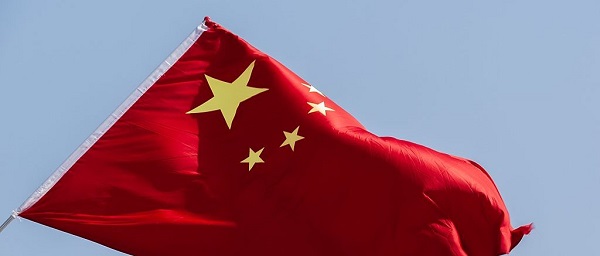
 Business2 days ago
Business2 days agoTrump Warns Beijing Of ‘Countermeasures’ As China Tightens Grip On Critical Resources
-

 International2 days ago
International2 days agoTrump gets an honourable mention: Nobel winner dedicates peace prize to Trump
-

 Business1 day ago
Business1 day agoTax filing announcement shows consultation was a sham
-

 Frontier Centre for Public Policy8 hours ago
Frontier Centre for Public Policy8 hours agoCanada’s Democracy Is Running On Fumes
-

 COVID-192 days ago
COVID-192 days agoTamara Lich says she has no ‘remorse,’ no reason to apologize for leading Freedom Convoy
-

 Business1 day ago
Business1 day agoCarney government plans to muddy the fiscal waters in upcoming budget






